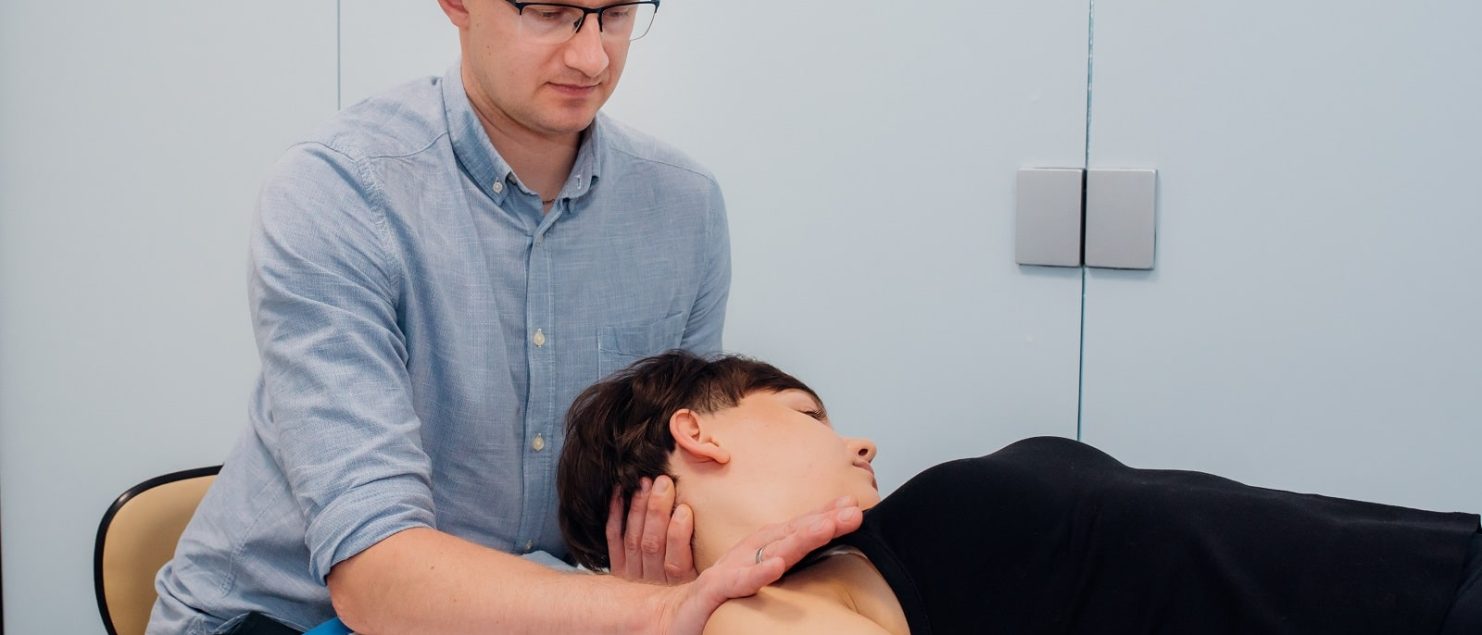Na czym polega osteopatia i kim właściwie jest osteopata?
Osteopata wykorzystuje szeroki wachlarz technik manualnych których celem jest poprawa funkcjonowania fizycznego i wspomaganie homeostazy, która uległa zaburzeniu przez dysfunkcję somatyczną. Tak mówi definicja (WHO 2010).
W czym może pomóc osteopata oraz czym jest osteopatia – wyjaśnia nasz specjalista mgr Piotr Kazek.
– Odchodząc od ścisłych definicji osteopatię można opisać jako naukę zawierającą w sobie anatomię, fizjologię i biomechanikę, która w sposób holistyczny analizuje człowieka, starając się poprzez usuwanie znalezionych barier, zachować zdrowie i zdolność do samoleczenia.
Opiera się na czterech podstawach, które są niejako konstytucją i określają one obraz człowieka z punktu widzenia osteopatów i tym samym ich pojmowanie medycyny.
ZASADA PIERWSZA – Człowiek jest jednością obejmującą ciało, umysł i duszę – Organizm składający się z kości, mięśni i innych organów połączony jest obiegami (układ nerwowy, krwionośny, powięziowy, gospodarka hormonalna), które przekazują komunikaty i reakcje organizmu. W ten sposób tworzą się zależności np. między aparatem ruchu a narządami wewnętrznymi. W efekcie tych korelacji np. bóle barku mogą być wywoływane problemem z wątrobą bądź żołądkiem. Nie powinna więc dziwić sytuacja, kiedy osteopata bada całe ciało, nawet gdy wydaje się oczywiste co dolega pacjentowi.
ZASADA DRUGA – Organizm potrafi samodzielnie się regulować, leczyć i utrzymywać w stanie zdrowia – odbywa się to nieświadomie, np. napięcie i stres kompensujemy wyładowując się i odreagowując w czasie wolnym ( sport, hobby). Nasze ciało świetnie radzi sobie samodzielnie – niewielkie rany zabliźniają się w ciągu kilku dni, liczne bakterie i wirusy są neutralizowane przez układ odpornościowy, a w czasie choroby następuje szereg reakcji adaptacyjnych organizmu.
ZASADA TRZECIA – Struktura i funkcja wzajemnie na siebie oddziałują – zdrowa struktura (m.in. mięśnie, nerwy narządy, płyny ustrojowe) wypełnia wszystkie funkcje, które do niej należą. Funkcje (np. przepływ krwi, trawienie, ruch, menstruacja)wykonywane przez organizm są dobre tylko wtedy, gdy struktury znajdują się w dobrym stanie.
ZASADA CZWARTA – ukrwienie jako najważniejszy czynnik – jedność ciała organizuje się wokół krwi, substancji, która jest wspólna dla wszystkich tkanek. Celem diagnostyki osteopatycznej jest znalezienie miejsca zablokowania. Przywrócenie prawidłowego przepływu krwi poprawia odżywienie tkanek, usunięcie metabolitów, a także zapobiega zablokowaniom i zwłóknieniom.
Jak wygląda wizyta u osteopaty?
– Na początku, w standardowy sposób, pacjent opowiada o swoich dolegliwościach i problemie. Następnie osteopata przechodzi do anamnezy zawierając kluczowe pytania o choroby współistniejące, przyjmowane leki, przebyte operacje i urazy, wypadki, a także codzienne nawyki i warunki pracy. Warto mieć także ze sobą wyniki dotychczasowych badań obrazowych. Najważniejszym środkiem pozwalającym postawić diagnozę osteopatyczną jest badanie fizykalne pacjenta. Oceniana jest symetria ciała, tkliwość tkanek, stan skóry, ilościowa i jakościowa ocena ruchu, przeprowadzane są funkcjonalne testy kliniczne.
Na czym polega leczenie osteopatyczne?
– Istnieje wiele technik i koncepcji leczenia osteopatycznego. Należy rozróżnić techniki pośrednie i bezpośrednie, których wspólnym mianownikiem powinien być brak bólu podczas ich wykonywania. Terapia powinna skupić się na odnalezieniu dysfunkcji somatycznych pacjenta i skategoryzowanie ich do dysfunkcji pierwotnych i wtórnych. Leczenie powinno być jak najmniej inwazyjne, nacelowane na pierwotny problem pacjenta, który z kolei spowodował kaskadę dalszych zmian w organizmie.
Najczęściej osteopata sugeruje terapię raz na tydzień bądź w cyklu dwutygodniowym. W stanie ostrym częstotliwość terapii może wzrosnąć do dwóch w tygodniu. Po każdej terapii należy zrobić kilka dni przerwy, aby organizm zaadaptował się do zmian napięciowych, jakie zaszły w ciele pacjenta podczas terapii.
Czy leczenie u osteopaty boli?
– Wspólnym mianownikiem różnych technik osteopatycznych powinien być brak bólu podczas ich wykonywania.
Co leczy specjalista osteopata?
– Z racji bardzo szerokiego spektrum postrzegania przez osteopatię ciała, jego bezpośrednich i pośrednich połączeń, zakres wspomagania ciała przez osteopatię jest naprawdę bardzo duży. Do najbardziej popularnych problemów, z którymi pracują osteopaci należą:
- bóle kręgosłupa,
- dyskopatie i radikulopatie,
- wady postawy,
- przeciążenia stawów,
- bóle i zawroty głowy,
- piski i szumy uszne,
- dolegliwości stawu skroniowo – żuchwowego,
- dolegliwości okołoporodowe,
- zespoły bólowe ciężarnych,
- bolesne miesiączki,
- zaburzenia trawienia,
- refluks przełykowo- żołądkowy,
- zespół jelita drażliwego,
- urazy i stany po złamaniach,
- kolki i reflux u niemowlaków.
Czy na zabiegi u osteopaty wymagane jest skierowanie od lekarza?
– Osteopata to osoba, która ukończyła studia o kierunku medycznym (lekarz, fizjoterapeuta) i odbyła 4-5 letnie osteopatyczne szkolenie podyplomowe, zakończone egzaminem i obronieniem pracy naukowej z dziedziny osteopatii. Stąd wizyta u osteopaty nie wymaga skierowania lekarskiego.
Jak zapisać się na wizytę ?
– Rejestracji wizyty można dokonać online lub telefonicznie 81 532 37 11. Wizyta odbywa się w przychodni CM Luxmed w Lublinie, przy ul. Zwycięska 6a. Czas trwania: 30 – 45 min.

